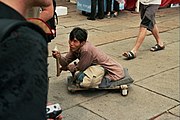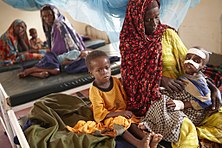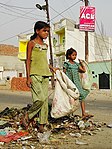A | B | C | D | E | F | G | H | CH | I | J | K | L | M | N | O | P | Q | R | S | T | U | V | W | X | Y | Z | 0 | 1 | 2 | 3 | 4 | 5 | 6 | 7 | 8 | 9
Poverty is a state or condition in which an individual lacks the financial resources and essentials for a certain standard of living. Poverty can have diverse environmental, legal, social, economic, and political causes and effects.[1] When evaluating poverty in statistics or economics there are two main measures: absolute poverty which compares income against the amount needed to meet basic personal needs, such as food, clothing, and shelter;[2] secondly, relative poverty measures when a person cannot meet a minimum level of living standards, compared to others in the same time and place. The definition of relative poverty varies from one country to another, or from one society to another.[2]
Statistically, as of 2019[update], most of the world's population live in poverty: in PPP dollars, 85% of people live on less than $30 per day, two-thirds live on less than $10 per day, and 10% live on less than $1.90 per day.[3] According to the World Bank Group in 2020, more than 40% of the poor live in conflict-affected countries.[4] Even when countries experience economic development, the poorest citizens of middle-income countries frequently do not gain an adequate share of their countries' increased wealth to leave poverty.[5] Governments and non-governmental organizations have experimented with a number of different policies and programs for poverty alleviation, such as electrification in rural areas or housing first policies in urban areas. The international policy frameworks for poverty alleviation, established by the United Nations in 2015, are summarized in Sustainable Development Goal 1: "No Poverty".
Social forces, such as gender, disability, race and ethnicity, can exacerbate issues of poverty—with women, children and minorities frequently bearing unequal burdens of poverty. Moreover, impoverished individuals are more vulnerable to the effects of other social issues, such as the environmental effects of industry or the impacts of climate change or other natural disasters or extreme weather events. Poverty can also make other social problems worse; economic pressures on impoverished communities frequently play a part in deforestation, biodiversity loss and ethnic conflict. For this reason, the UN's Sustainable Development Goals and other international policy programs, such as the international recovery from COVID-19, emphasize the connection of poverty alleviation with other societal goals.[6]
Definitions and etymology
The word poverty comes from the old (Norman) French word poverté (Modern French: pauvreté), from Latin paupertās from pauper (poor).[7]
There are several definitions of poverty depending on the context of the situation it is placed in. It usually references a state or condition in which a person or community lacks the financial resources and essentials for a certain standard of living.
United Nations: Fundamentally, poverty is a denial of choices and opportunities, a violation of human dignity. It means lack of basic capacity to participate effectively in society. It means not having enough to feed and clothe a family, not having a school or clinic to go to, not having the land on which to grow one's food or a job to earn one's living, not having access to credit. It means insecurity, powerlessness and exclusion of individuals, households and communities. It means susceptibility to violence, and it often implies living in marginal or fragile environments, without access to clean water or sanitation.[8]
World Bank: Poverty is pronounced deprivation in well-being, and comprises many dimensions. It includes low incomes and the inability to acquire the basic goods and services necessary for survival with dignity. Poverty also encompasses low levels of health and education, poor access to clean water and sanitation, inadequate physical security, lack of voice, and insufficient capacity and opportunity to better one's life.[9]
European Union (EU): The European Union's definition of poverty is significantly different from definitions in other parts of the world, and consequently policy measures introduced to combat poverty in EU countries also differ from measures in other nations. Poverty is measured in relation to the distribution of income in each member country using relative income poverty lines.[10] Relative-income poverty rates in the EU are compiled by the Eurostat, in charge of coordinating, gathering, and disseminating member country statistics using European Union Survey of Income and Living Conditions (EU-SILC) surveys.[10]
Measuring poverty
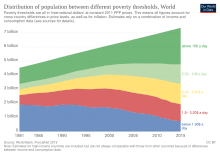
Absolute poverty

Absolute poverty, often synonymous with 'extreme poverty' or 'abject poverty', refers to a set standard which is consistent over time and between countries. This set standard usually refers to "a condition characterized by severe deprivation of basic human needs, including food, safe drinking water, sanitation facilities, health, shelter, education and information. It depends not only on income but also on access to services."[12][13][14] Having an income below the poverty line, which is defined as an income needed to purchase basic needs, is also referred to as primary poverty.
The "dollar a day" poverty line was first introduced in 1990 as a measure to meet such standards of living. For nations that do not use the US dollar as currency, "dollar a day" does not translate to living a day on the equivalent amount of local currency as determined by the exchange rate.[15] Rather, it is determined by the purchasing power parity rate, which would look at how much local currency is needed to buy the same things that a dollar could buy in the United States.[15] Usually, this would translate to having less local currency than if the exchange rate were used.[15]
From 1993 through 2005, the World Bank defined absolute poverty as $1.08 a day on such a purchasing power parity basis, after adjusting for inflation to the 1993 US dollar[16] In 2009, it was updated as $1.25 a day (equivalent to $1.00 a day in 1996 US prices)[17][18] and in 2015, it was updated as living on less than US$1.90 per day,[19] and moderate poverty as less than $2 or $5 a day.[20] Similarly, 'ultra-poverty' is defined by a 2007 report issued by International Food Policy Research Institute as living on less than 54 cents per day.[21] The poverty line threshold of $1.90 per day, as set by the World Bank, is controversial. Each nation has its own threshold for absolute poverty line; in the United States, for example, the absolute poverty line was US$15.15 per day in 2010 (US$22,000 per year for a family of four),[22] while in India it was US$1.0 per day[23] and in China the absolute poverty line was US$0.55 per day, each on PPP basis in 2010.[24] These different poverty lines make data comparison between each nation's official reports qualitatively difficult. Some scholars argue that the World Bank method sets the bar too high,[25] others argue it is too low.
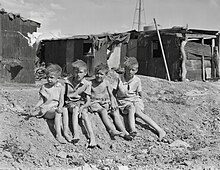
There is disagreement among experts as to what would be considered a realistic poverty rate with one considering it "an inaccurately measured and arbitrary cut off".[26] Some contend that a higher poverty line is needed, such as a minimum of $7.40 or even $10 to $15 a day. They argue that these levels are a minimum for basic needs and to achieve normal life expectancy.[27]
One estimate places the true scale of poverty much higher than the World Bank, with an estimated 4.3 billion people (59% of the world's population) living with less than $5 a day and unable to meet basic needs adequately.[28] Philip Alston, a UN special rapporteur on extreme poverty and human rights, stated the World Bank's international poverty line of $1.90 a day is fundamentally flawed, and has allowed for "self congratulatory" triumphalism in the fight against extreme global poverty, which he asserts is "completely off track" and that nearly half of the global population, or 3.4 billion, lives on less than $5.50 a day, and this number has barely moved since 1990.[29] Still others suggest that poverty line misleads because many live on far less than that line.[23][30][31]
Other measures of absolute poverty without using a certain dollar amount include the standard defined as receiving less than 80% of minimum caloric intake whilst spending more than 80% of income on food, sometimes called ultra-poverty.[32]
Relative poverty

Relative poverty views poverty as socially defined and dependent on social context. It is argued that the needs considered fundamental is not an objective measure[33][34] and could change with the custom of society.[35][33] For example, a person who cannot afford housing better than a small tent in an open field would be said to live in relative poverty if almost everyone else in that area lives in modern brick homes, but not if everyone else also lives in small tents in open fields (for example, in a nomadic tribe). Since richer nations would have lower levels of absolute poverty,[36][37] relative poverty is considered the "most useful measure for ascertaining poverty rates in wealthy developed nations"[38][39][40][41][42] and is the "most prominent and most-quoted of the EU social inclusion indicators".[43]
Usually, relative poverty is measured as the percentage of the population with income less than some fixed proportion of median income. This is a calculation of the percentage of people whose family household income falls below the Poverty Line. The main poverty line used in the Organisation of Economic Cooperation and Development (OECD) and the European Union (EU) is based on "economic distance", a level of income set at 60% of the median household income.[44] The United States federal government typically regulates this line to three times the cost of an adequate meal.[45]
There are several other different income inequality metrics, for example, the Gini coefficient or the Theil Index.


Other aspects

≥ 0.900 0.850–0.899 0.800–0.849 0.750–0.799 0.700–0.749 | 0.650–0.699 0.600–0.649 0.550–0.599 0.500–0.549 0.450–0.499 | 0.400–0.449 ≤ 0.399 Data unavailable |
Rather than income, poverty is also measured through individual basic needs at a time. Life expectancy has greatly increased in the developing world since World War II and is starting to close the gap to the developed world.[47] Child mortality has decreased in every developing region of the world.[48] The proportion of the world's population living in countries where the daily per-capita supply of food energy is less than 9,200 kilojoules (2,200 kilocalories) decreased from 56% in the mid-1960s to below 10% by the 1990s. Similar trends can be observed for literacy, access to clean water and electricity and basic consumer items.[49]
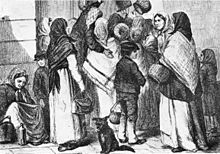
Poverty may also be understood as an aspect of unequal social status and inequitable social relationships, experienced as social exclusion, dependency, and diminished capacity to participate, or to develop meaningful connections with other people in society.[50][51][52] Such social exclusion can be minimized through strengthened connections with the mainstream, such as through the provision of relational care to those who are experiencing poverty. The World Bank's "Voices of the Poor", based on research with over 20,000 poor people in 23 countries, identifies a range of factors which poor people identify as part of poverty. These include abuse by those in power, dis-empowering institutions, excluded locations, gender relationships, lack of security, limited capabilities, physical limitations, precarious livelihoods, problems in social relationships, weak community organizations and discrimination. Analysis of social aspects of poverty links conditions of scarcity to aspects of the distribution of resources and power in a society and recognizes that poverty may be a function of the diminished "capability" of people to live the kinds of lives they value. The social aspects of poverty may include lack of access to information, education, health care, social capital or political power.[53][54] Relational poverty is the idea that societal poverty exists if there is a lack of human relationships. Relational poverty can be the result of a lost contact number, lack of phone ownership, isolation, or deliberate severing of ties with an individual or community. Relational poverty is also understood "by the social institutions that organize those relationships...poverty is importantly the result of the different terms and conditions on which people are included in social life".[55]
In the United Kingdom, the second Cameron ministry came under attack for its redefinition of poverty; poverty is no longer classified by a family's income, but as to whether a family is in work or not.[56] Considering that two-thirds of people who found work were accepting wages that are below the living wage (according to the Joseph Rowntree Foundation[57]) this has been criticised by anti-poverty campaigners as an unrealistic view of poverty in the United Kingdom.[56]
Secondary poverty
Secondary poverty refers to those that earn enough income to not be impoverished, but who spend their income on unnecessary pleasures, such as alcoholic beverages, thus placing them below it in practice.[58] In 18th- and 19th-century Great Britain, the practice of temperance among Methodists, as well as their rejection of gambling, allowed them to eliminate secondary poverty and accumulate capital.[59] Factors that contribute to secondary poverty includes but are not limited to: alcohol, gambling, tobacco and drugs. Substance abuse means that the poor typically spend about 2% of their income educating their children but larger percentages of alcohol and tobacco (for example, 6% in Indonesia and 8% in Mexico).[60]
Variability
Poverty levels are snapshot pictures in time that omits the transitional dynamics between levels. Mobility statistics supply additional information about the fraction who leave the poverty level. For example, one study finds that in a sixteen-year period (1975 to 1991 in the US) only 5% of those in the lower fifth of the income level were still at that level, while 95% transitioned to a higher income category.[61] Poverty levels can remain the same while those who rise out of poverty are replaced by others. The transient poor and chronic poor differ in each society. In a nine-year period ending in 2005 for the US, 50% of the poorest quintile transitioned to a higher quintile.[62]
Global prevalence
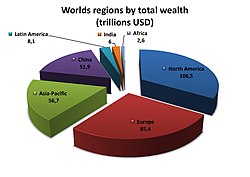
According to Chen and Ravallion, about 1.76 billion people in developing world lived above $1.25 per day and 1.9 billion people lived below $1.25 per day in 1981. In 2005, about 4.09 billion people in developing world lived above $1.25 per day and 1.4 billion people lived below $1.25 per day (both 1981 and 2005 data are on inflation adjusted basis).[63][64] The share of the world's population living in absolute poverty fell from 43% in 1981 to 14% in 2011.[65] The absolute number of people in poverty fell from 1.95 billion in 1981 to 1.01 billion in 2011.[66] The economist Max Roser estimates that the number of people in poverty is therefore roughly the same as 200 years ago.[66] This is the case since the world population was just little more than 1 billion in 1820 and the majority (84% to 94%)[67] of the world population was living in poverty. According to one study, the percentage of the world population in hunger and poverty fell in absolute percentage terms from 50% in 1950 to 30% in 1970.[68] According to another study the number of people worldwide living in absolute poverty fell from 1.18 billion in 1950 to 1.04 billion in 1977.[69] According to another study, the number of people worldwide estimated to be starving fell from almost 920 million in 1971 to below 797 million in 1997.[70] The proportion of the developing world's population living in extreme economic poverty fell from 28% in 1990 to 21% in 2001.[65] Most of this improvement has occurred in East and South Asia.[71]
In 2012 it was estimated that, using a poverty line of $1.25 a day, 1.2 billion people lived in poverty.[72] Given the current economic model, built on GDP, it would take 100 years to bring the world's poorest up to the poverty line of $1.25 a day.[73] UNICEF estimates half the world's children (or 1.1 billion) live in poverty.[74] The World Bank forecasted in 2015 that 702.1 million people were living in extreme poverty, down from 1.75 billion in 1990.[75] Extreme poverty is observed in all parts of the world, including developed economies.[76][77] Of the 2015 population, about 347.1 million people (35.2%) lived in Sub-Saharan Africa and 231.3 million (13.5%) lived in South Asia. According to the World Bank, between 1990 and 2015, the percentage of the world's population living in extreme poverty fell from 37.1% to 9.6%, falling below 10% for the first time.[78] During the 2013 to 2015 period, the World Bank reported that extreme poverty fell from 11% to 10%, however they also noted that the rate of decline had slowed by nearly half from the 25 year average with parts of sub-saharan Africa returning to early 2000 levels.[79][80] The World Bank attributed this to increasing violence following the Arab Spring, population increases in Sub-Saharan Africa, and general African inflationary pressures and economic malaise were the primary drivers for this slow down.[81][82] Many wealthy nations have seen an increase in relative poverty rates ever since the Great Recession, in particular among children from impoverished families who often reside in substandard housing and find educational opportunities out of reach.[83] It has been argued by some academics that the neoliberal policies promoted by global financial institutions such as the IMF and the World Bank are actually exacerbating both inequality and poverty.[84][85]
In East Asia the World Bank reported that "The poverty headcount rate at the $2-a-day level is estimated to have fallen to about 27 percent , down from 29.5 percent in 2006 and 69 percent in 1990."[86] The People's Republic of China accounts for over three quarters of global poverty reduction from 1990 to 2005, which according to the World Bank is "historically unprecedented".[87] China accounted for nearly half of all extreme poverty in 1990.[88]
In Sub-Saharan Africa extreme poverty went up from 41% in 1981 to 46% in 2001,[89] which combined with growing population increased the number of people living in extreme poverty from 231 million to 318 million.[90] Statistics of 2018 shows population living in extreme conditions has declined by more than 1 billion in the last 25 years. As per the report published by the world bank on 19 September 2018 world poverty falls below 750 million.[91]
In the early 1990s some of the transition economies of Central and Eastern Europe and Central Asia experienced a sharp drop in income.[92] The collapse of the Soviet Union resulted in large declines in GDP per capita, of about 30 to 35% between 1990 and the through year of 1998 (when it was at its minimum). As a result, poverty rates tripled,[93] excess mortality increased,[94] and life expectancy declined.[95] Russian President Boris Yeltsin's IMF-backed rapid privatization and austerity policies resulted in unemployment rising to double digits and half the Russian population falling into destitution by the early to mid 1990s.[96] By 1999, during the peak of the poverty crisis, 191 million people were living on less than $5.50 a day.[97] In subsequent years as per capita incomes recovered the poverty rate dropped from 31.4% of the population to 19.6%.[98][99] The average post-communist country had returned to 1989 levels of per-capita GDP by 2005,[100] although as of 2015 some are still far behind that.[101] According to the World Bank in 2014, around 80 million people were still living on less than $5.00 a day.[97]
World Bank data shows that the percentage of the population living in households with consumption or income per person below the poverty line has decreased in each region of the world except Middle East and North Africa since 1990:[102][103]
In July 2023, a group of over 200 economists from 67 countries, including Jayati Ghosh, Joseph Stiglitz and Thomas Piketty, sent a letter to the United Nations secretary general António Guterres and World Bank president Ajay Banga warning that "extreme poverty and extreme wealth have risen sharply and simultaneously for the first time in 25 years."[104] In 2024, Oxfam reported that roughly five billion people have become poorer since 2020 and warned that current trends could postpone global poverty eradication for 229 years.[105]
| Region | $2.15 per day[106] | |||||
|---|---|---|---|---|---|---|
| 1981 | 1990 | 2000 | 2010 | 2018 | 2019 | |
| East Asia and Pacific | 83.5% | 65.8% | 39.5% | 13.3% | 1.6% | 1.2% |
| Europe and Central Asia | — | — | 9.1% | 4.1% | 2.3% | 2.3% |
| Latin America and the Caribbean | 15.1% | 16.8% | 13.5% | 6.4% | 4.3% | 4.3% |
| Middle East and North Africa | — | 6.5% | 3.5% | 1.9% | 9.6% | — |
| South Asia | 58% | 49.8% | — | 26% | 10.1% | 8.6% |
| Sub-Saharan Africa | — | 53.8% | 56.5% | 42.2% | 35.4% | 34.9% |
| World | 43.6% | 37.9% | 29.3% | 16.3% | 9% | 8.5% |
Characteristics

The effects of poverty may also be causes as listed above, thus creating a "poverty cycle" operating across multiple levels, individual, local, national and global.

Health

One-third of deaths around the world—some 18 million people a year or 50,000 per day—are due to poverty-related causes. People living in developing nations, among them women and children, are over represented among the global poor and these effects of severe poverty.[107][108][109] Those living in poverty suffer disproportionately from hunger or even starvation and disease, as well as lower life expectancy.[110][111] According to the World Health Organization, hunger and malnutrition are the single gravest threats to the world's public health and malnutrition is by far the biggest contributor to child mortality, present in half of all cases.[112]
Almost 90% of maternal deaths during childbirth occur in Asia and sub-Saharan Africa, compared to less than 1% in the developed world.[113] Those who live in poverty have also been shown to have a far greater likelihood of having or incurring a disability within their lifetime.[114] Infectious diseases such as malaria and tuberculosis can perpetuate poverty by diverting health and economic resources from investment and productivity; malaria decreases GDP growth by up to 1.3% in some developing nations and AIDS decreases African growth by 0.3–1.5% annually.[115][116][117]
Studies have shown that poverty impedes cognitive function although some of these findings could not be replicated in follow-up studies.[118] One hypothesised mechanism is that financial worries put a severe burden on one's mental resources so that they are no longer fully available for solving complicated problems. The reduced capability for problem solving can lead to suboptimal decisions and further perpetuate poverty.[119] Many other pathways from poverty to compromised cognitive capacities have been noted, from poor nutrition and environmental toxins to the effects of stress on parenting behavior, all of which lead to suboptimal psychological development.[120][121] Neuroscientists have documented the impact of poverty on brain structure and function throughout the lifespan.[122]
Infectious diseases continue to blight the lives of the poor across the world. 36.8 million people are living with HIV/AIDS, with 954,492 deaths in 2017.[123]
Poor people often are more prone to severe diseases due to the lack of health care, and due to living in non-optimal conditions. Among the poor, girls tend to suffer even more due to gender discrimination. Economic stability is paramount in a poor household; otherwise they go in an endless loop of negative income trying to treat diseases. Often when a person in a poor household falls ill it is up to the family members to take care of them due to limited access to health care and lack of health insurance. The household members often have to give up their income or stop seeking further education to tend to the sick member. There is a greater opportunity cost imposed on the poor to tend to someone compared to someone with better financial stability.[124] Increased access to healthcare and improved health outcomes help prevent individuals from falling into poverty due to medical expenses.[125][126]
Hunger

It is estimated that 1.02 billion people go to bed hungry every night.[127] According to the Global Hunger Index, Sub-Saharan Africa had the highest child malnutrition rate of the world's regions over the 2001–2006 period.[128]
Poor people spend a greater portion of their budgets on food than wealthy people and, as a result, they can be particularly vulnerable to increases in food prices. For example, in late 2007, increases in the price of grains[129] led to food riots in some countries.[130][131][132] Threats to the supply of food may also be caused by drought and the water crisis.[133] Intensive farming often leads to a vicious cycle of exhaustion of soil fertility and decline of agricultural yields.[134] Approximately 40% of the world's agricultural land is seriously degraded.[135][136] Goal 2 of the Sustainable Development Goals is the elimination of hunger and undernutrition by 2030.[137]
Mental health

A psychological study has been conducted by four scientists during inaugural Convention of Psychological Science. The results find that people who thrive with financial stability or fall under low socioeconomic status (SES) tend to perform worse cognitively due to external pressure imposed upon them. The research found that stressors such as low income, inadequate health care, discrimination, and exposure to criminal activities all contribute to mental disorders. This study also found that children exposed to poverty-stricken environments have slower cognitive thinking.[138] It is seen that children perform better under the care of their parents and that children tend to adopt speaking language at a younger age. Since being in poverty from childhood is more harmful than it is for an adult, it is seen that children in poor households tend to fall behind in certain cognitive abilities compared to other average families.[139]
For a child to grow up emotionally healthy, the children under three need "A strong, reliable primary caregiver who provides consistent and unconditional love, guidance, and support. Safe, predictable, stable environments. Ten to 20 hours each week of harmonious, reciprocal interactions. This process, known as attunement, is most crucial during the first 6–24 months of infants' lives and helps them develop a wider range of healthy emotions, including gratitude, forgiveness, and empathy. Enrichment through personalized, increasingly complex activities".[citation needed] In one survey, 67% of children from disadvantaged inner cities said they had witnessed a serious assault, and 33% reported witnessing a homicide.[140] 51% of fifth graders from New Orleans (median income for a household: $27,133) have been found to be victims of violence, compared to 32% in Washington, DC (mean income for a household: $40,127).[141] Studies have shown that poverty changes the personalities of children who live in it. The Great Smoky Mountains Study was a ten-year study that was able to demonstrate this. During the study, about one-quarter of the families saw a dramatic and unexpected increase in income. The study showed that among these children, instances of behavioral and emotional disorders decreased, and conscientiousness and agreeableness increased.[142]
Education
Research has found that there is a high risk of educational underachievement for children who are from low-income housing circumstances. This is often a process that begins in primary school. Instruction in the US educational system, as well as in most other countries, tends to be geared towards those students who come from more advantaged backgrounds. As a result, children in poverty are at a higher risk than advantaged children for retention in their grade, special deleterious placements during the school's hours and not completing their high school education.[143] Advantage breeds advantage.[144] There are many explanations for why students tend to drop out of school. One is the conditions in which they attend school. Schools in poverty-stricken areas have conditions that hinder children from learning in a safe environment. Researchers have developed a name for areas like this: an urban war zone is a poor, crime-laden district in which deteriorated, violent, even warlike conditions and underfunded, largely ineffective schools promote inferior academic performance, including irregular attendance and disruptive or non-compliant classroom behavior.[145] Because of poverty, "Students from low-income families are 2.4 times more likely to drop out than middle-income kids, and over 10 times more likely than high-income peers to drop out."[146]
For children with low resources, the risk factors are similar to others such as juvenile delinquency rates, higher levels of teenage pregnancy, and economic dependency upon their low-income parent or parents.[143] Families and society who submit low levels of investment in the education and development of less fortunate children end up with less favorable results for the children who see a life of parental employment reduction and low wages. Higher rates of early childbearing with all the connected risks to family, health and well-being are major issues to address since education from preschool to high school is identifiably meaningful in a life.[143]

Poverty often drastically affects children's success in school. A child's "home activities, preferences, mannerisms" must align with the world and in the cases that they do not do these, students are at a disadvantage in the school and, most importantly, the classroom.[147] Therefore, it is safe to state that children who live at or below the poverty level will have far less success educationally than children who live above the poverty line. Poor children have a great deal less healthcare and this ultimately results in many absences from school. Additionally, poor children are much more likely to suffer from hunger, fatigue, irritability, headaches, ear infections, flu, and colds.[147] These illnesses could potentially restrict a student's focus and concentration.[148]
In general, the interaction of gender with poverty or location tends to work to the disadvantage of girls in poorer countries with low completion rates and social expectations that they marry early, and to the disadvantage of boys in richer countries with high completion rates but social expectations that they enter the labour force early.[149] At the primary education level, most countries with a completion rate below 60% exhibit gender disparity at girls' expense, particularly poor and rural girls. In Mauritania, the adjusted gender parity index is 0.86 on average, but only 0.63 for the poorest 20%, while there is parity among the richest 20%. In countries with completion rates between 60% and 80%, gender disparity is generally smaller, but disparity at the expense of poor girls is especially marked in Cameroon, Nigeria and Yemen. Exceptions in the opposite direction are observed in countries with pastoralist economies that rely on boys' labour, such as the Kingdom of Eswatini, Lesotho and Namibia.[149]
Shelter
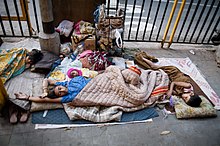

The right to housing is argued to be a human right.[151][152] Higher density and lower cost housing affords low-income families and first-time homebuyers with more and less expensive shelter opportunities, reducing economic inequality.[153][154]
The geographic concentration of poverty is argued to be a factor in entrenching poverty. William J. Wilson's "concentration and isolation" hypothesis states that the economic difficulties of the very poorest African Americans are compounded by the fact that as the better-off African Americans move out, the poorest are more and more concentrated, having only other very poor people as neighbors. This concentration causes social isolation, Wilson suggests, because the very poor are now isolated from access to the job networks, role models, institutions, and other connections that might help them escape poverty.[155] Gentrification means converting an aging neighborhood into a more affluent one, as by remodeling homes. Landlords then increase rent on newly renovated real estate; the poor people cannot afford to pay high rent, and may need to leave their neighborhood to find affordable housing.[156] The poor also get more access to income and services, while studies suggest poor residents living in gentrifying neighbourhoods are actually less likely to move than poor residents of non-gentrifying areas.[157]
Poverty increases the risk of homelessness.[158] Slum-dwellers, who make up a third of the world's urban population, live in a poverty no better, if not worse, than rural people, who are the traditional focus of the poverty in the developing world, according to a report by the United Nations.[159]
There are over 100 million street children worldwide.[160] Most of the children living in institutions around the world have a surviving parent or close relative, and they most commonly entered orphanages because of poverty.[150] It is speculated that, flush with money, for-profit orphanages are increasing and push for children to join even though demographic data show that even the poorest extended families usually take in children whose parents have died.[150] Many child advocates maintain that this can harm children's development by separating them from their families and that it would be more effective and cheaper to aid close relatives who want to take in the orphans.[150]
Utilities

The poor tend to pay more for access to utilities and ensuring the availability of water, sanitation, energy, and telecommunication services such as broadband internet service[161] help in reducing poverty in general.[162][163]
Water and sanitation
As of 2012, 2.5 billion people lack access to sanitation services and 15% practice open defecation.[164] Even while providing latrines is a challenge, people still do not use them even when available. Bangladesh had half the GDP per capita of India but has a lower mortality from diarrhea than India or the world average, with diarrhea deaths declining by 90% since the 1990s. By strategically providing pit latrines to the poorest, charities in Bangladesh sparked a cultural change as those better off perceived it as an issue of status to not use one. The vast majority of the latrines built were then not from charities but by villagers themselves.[165]
Water utility subsidies tend to subsidize water consumption by those connected to the supply grid, which is typically skewed towards the richer and urban segment of the population and those outside informal housing. As a result of heavy consumption subsidies, the price of water decreases to the extent that only 30%, on average, of the supplying costs in developing countries is covered.[166][167] This results in a lack of incentive to maintain delivery systems, leading to losses from leaks annually that are enough for 200 million people.[166][168] This also leads to a lack of incentive to invest in expanding the network, resulting in much of the poor population being unconnected to the network. Instead, the poor buy water from water vendors for, on average, about 5 to 16 times the metered price.[166][169] However, subsidies for laying new connections to the network rather than for consumption have shown more promise for the poor.[167]
Energy
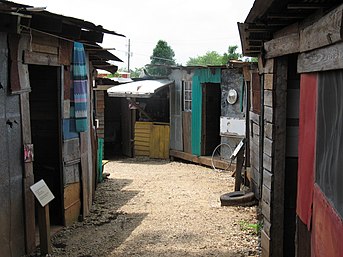
In developing countries and some areas of more developed countries, energy poverty is lack of access to modern energy services in the home.[170] In 2022, 759 million people lacked access to consistent electricity and 2.6 billion people used dangerous and inefficient cooking systems.[171] Their well-being is negatively affected by very low consumption of energy, use of dirty or polluting fuels, and excessive time spent collecting fuel to meet basic needs.
Predominant indices for measuring the complex nature of energy poverty include the Energy Development Index (EDI), the Multidimensional Energy Poverty Index (MEPI), and Energy Poverty Index (EPI). Both binary and multidimensional measures of energy poverty are required to establish indicators that simplify the process of measuring and tracking energy poverty globally.[172] Energy poverty often exacerbates existing vulnerabilities amongst underprivileged communities and negatively impacts public and household health, education, and women's opportunities.[173]
According to the Energy Poverty Action initiative of the World Economic Forum, "Access to energy is fundamental to improving quality of life and is a key imperative for economic development. In the developing world, energy poverty is still rife."[174] As a result of this situation, the United Nations (UN) launched the Sustainable Energy for All Initiative and designated 2012 as the International Year for Sustainable Energy for All, which had a major focus on reducing energy poverty.
The term energy poverty is also sometimes used in the context of developed countries to mean an inability to afford energy in the home. This concept is also known as fuel poverty or household energy insecurity.[170]Financial services
For low-income individuals and families, access to credit can be limited, predatory, or both, making it difficult to find the financial resources they need to invest in their futures.[175][176]
Prejudice and exploitation

Cultural factors, such as discrimination of various kinds, can negatively affect productivity such as age discrimination, stereotyping,[177] discrimination against people with physical disability,[178] gender discrimination, racial discrimination, and caste discrimination. Children are more than twice as likely to live in poverty as adults.[179] Women are the group suffering from the highest rate of poverty after children, in what is referred to as the feminization of poverty. In addition, the fact that women are more likely to be caregivers, regardless of income level, to either the generations before or after them, exacerbates the burdens of their poverty.[180] Those in poverty have increased chances of incurring a disability which leads to a cycle where disability and poverty are mutually reinforcing.
Max Weber and some schools of modernization theory suggest that cultural values could affect economic success.[181][182] However, researchers[who?] have gathered evidence that suggest that values are not as deeply ingrained and that changing economic opportunities explain most of the movement into and out of poverty, as opposed to shifts in values.[183] A 2018 report on poverty in the United States by UN special rapporteur Philip Alston asserts that caricatured narratives about the rich and the poor (that "the rich are industrious, entrepreneurial, patriotic and the drivers of economic success" while "the poor are wasters, losers and scammers") are largely inaccurate, as "the poor are overwhelmingly those born into poverty, or those thrust there by circumstances largely beyond their control, such as physical or mental disabilities, divorce, family breakdown, illness, old age, unlivable wages or discrimination in the job market."[184] Societal perception of people experiencing economic difficulty has historically appeared as a conceptual dichotomy: the "good" poor (people who are physically impaired, disabled, the "ill and incurable," the elderly, pregnant women, children) vs. the "bad" poor (able-bodied, "valid" adults, most often male).[185]
According to experts, many women become victims of trafficking, the most common form of which is prostitution, as a means of survival and economic desperation.[186] Deterioration of living conditions can often compel children to abandon school to contribute to the family income, putting them at risk of being exploited.[187] For example, in Zimbabwe, a number of girls are turning to sex in return for food to survive because of the increasing poverty.[188] According to studies, as poverty decreases there will be fewer and fewer instances of violence.[189] Some data such as the UNICEF reports and also a research called "Echo of Silence" show that there is a close correlation between economic poverty and early marriage. In some developing countries, child marriage is considered an economic measure that can improve the family’s poor condition, strengthen family bonds.[190][191][192][193]
Poverty reduction
Zdroj:https://en.wikipedia.org?pojem=Urban_poverty>Text je dostupný pod licencí Creative Commons Uveďte autora – Zachovejte licenci, případně za dalších podmínek. Podrobnosti naleznete na stránce Podmínky užití.
Poverty (disambiguation)
Welfare
File:Homeless man in Toronto across from old City Hall.jpg
File:Bettler peking1.jpg
File:Oxfam East Africa - Luli looks after her severely malnourished child Aden.jpg
File:LucknowTrashPickers.jpg
Toronto
Canada
Disabled
Beijing
Waste picker
Lucknow
Malnourished
Dadaab
Biophysical environment
Legal
Social
Economic
Political
Absolute poverty
Basic needs
Food
Clothing
Shelter (building)
Relative poverty
Living standards
Society
Purchasing Power Parity
Economic development
Poverty alleviation
Rural electrification
Housing First
United Nations
Sustainable Development Goal 1
Feminization of poverty
Disability and poverty
Racial inequality
Child poverty
Environmental justice
Climate change and poverty
Natural disaster
Extreme weather
Social problems
Deforestation
Causes of biodiversity loss
Ethnic conflict
Sustainable Development Goals
Standard of living
United Nations
World Bank
Dimension
Survival skills
European Union
Eurostat
Statistics
European Union
File:The number of people below different poverty lines.svg
Measuring poverty
Poverty threshold
Individual Deprivation Measure
File:Poverty headcount ratio at 1.90 a day.png
List of countries by percentage of population living in poverty
World Bank
Extreme poverty
Purchasing power
Asset poverty
Extreme poverty
Poverty line
Exchange rate
Purchasing power parity
World Bank
Purchasing power parity
File:Children of migrant cotton field workers from Sweetwater, Oklahoma, 8b15324.jpg
Great Depression
Life expectancy
Philip Alston
United Nations special rapporteur
Relative deprivation
Economic inequality
Wealth concentration
File:Economics Gini coefficient2.svg
Gini coefficient
Social context
Nomadic tribe
Poverty threshold
Income inequality metrics
Gini coefficient
Theil Index
File:Global Wealth Distribution 2020 (Property).svg
File:GINI index World Bank up to 2018.png
Gini coefficient
Economic inequality
World Bank
File:Countries by Human Development Index (2020).png
Human Development Index
Life expectancy
Child mortality
Food energy
File:Tiggare vid Operakällaren.jpg
Sweden
Social status
Relational care
Information access
Education
Health care
Social capital
Political power
Relational poverty
United Kingdom
Second Cameron ministry
Living wage
Joseph Rowntree Foundation
Secondary poverty
Alcoholic beverage
Great Britain
Temperance movement
Methodist
Gambling#Religious
Substance abuse
List of countries by percentage of population living in poverty
File:Worlds regions by total wealth(in trillions USD), 2018.jpg
Max Roser
Developing world
East Asia
South Asia
Gross domestic product
UNICEF
Global Monitoring Report (World Bank)
Global Monitoring Report (World Bank)
Global Monitoring Report (World Bank)
World Bank Group
Arab Spring
Population growth
Great Recession
Neoliberal
International Monetary Fund
People's Republic of China
Extreme poverty
Collapse of the Soviet Union
Boris Yeltsin
IMF
Privatization
Austerity
Jayati Ghosh
Joseph Stiglitz
Thomas Piketty
António Guterres
Ajay Banga
File:Life expectancy 1950-2005.png
AIDS epidemic
File:VOA Heinlein - Somali refugees September 2011 - 09.jpg
Diplomatic and humanitarian efforts in the Somali Civil War
Diseases of poverty
Disability and poverty
File:Expectancy of life CIA2016.svg
Life expectancy
Starvation
Life expectancy
World Health Organization
Hunger
Malnutrition
Child mortality
Maternal death
Disability and Poverty
Infectious diseases
Malaria
Tuberculosis
Developing country
Opportunity cost
File:Hunger Map 2020 World Food Programme.svg
World Food Programme
Hunger
Malnutrition
Global Hunger Index
Engel's law
Food prices
2007–2008 world food price crisis
Water security
Intensive farming
Erosion
Agricultural yields
Agricultural land
Sustainable Development Goals
File:Venezuelan eating from garbage.jpg
Crisis in Bolivarian Venezuela
Causes of mental disorders#Poverty
Wikipedia:Citation needed
Inner city
New Orleans
Great Smoky Mountains Study
Social determinants of health in poverty#Education
Disability and poverty#Education
Juvenile delinquency
Teenage pregnancy
File:Situation Analysis of Out-of-School Children in Nine Southeast Asian Countries.pdf
Gender
Girl
Boy
Labour force
Primary education
Gender disparity
Cameroon
Nigeria
Yemen
Eswatini
Lesotho
Namibia
Slums
Street children
Orphanages
Gentrification
File:Kolkata (4131122903).jpg
File:Street Child, Srimangal Railway Station.jpg
Bangladesh
Right to housing
Human rights
High density housing
Affordable housing
Gentrification
Homelessness
Developing world
Street children
Child development
File:Toilet at a Village near Jaipur installed by Pronto Panels.JPG
Jaipur, Rajasthan
Open defecation
Energy poverty
File:HFHI GVDC Poverty Housing.JPG
Developing country
Energy poverty
Energy
World Economic Forum
United Nations
Sustainable Energy for All
Fuel poverty
Household energy insecurity
Predatory lending
Loan shark
Credit
Predatory lending
Criminalization of poverty
File:Oxfam East Africa - SomalilandDrought022.jpg
Ageism
Stereotype
Sexism
Racism
Caste
Child poverty
Feminization of poverty
Disability and poverty
Max Weber
Modernization theory
Value (personal and cultural)
Wikipedia:Manual of Style/Words to watch#Unsupported attributions
Poverty in the United States
Philip Alston
Survival sex
Zimbabwe
UNICEF
Echo of Silence (book)
Child marriage
Poverty reduction
Aid
Development aid
Poverty
Poverty
Poverty
Main Page
Wikipedia:Contents
Portal:Current events
Special:Random
Wikipedia:About
Wikipedia:Contact us
Special:FundraiserRedirector?utm source=donate&utm medium=sidebar&utm campaign=C13 en.wikipedia.org&uselang=en
Help:Contents
Help:Introduction
Wikipedia:Community portal
Special:RecentChanges
Wikipedia:File upload wizard
Main Page
Special:Search
Help:Introduction
Special:MyContributions
Special:MyTalk
Armoede
Аӷарра
فقر
Pobreza
দৰিদ্ৰতা
Probeza
Sogue
Yoxsulluq
یوخسوللوق
দারিদ্র্য
Sàn-chhiah
Ярлылыҡ
Беднасць
Беднасьць
गरीबी
Katikapohan
Бедност
དབུལ་ཕོངས།
Siromaštvo
Paourentez
Pobresa
Чухăнлăх
Chudoba
Tlodi
Fattigdom
Aarmut
Armut
Vaesus
Φτώχεια
Pobreza
Malriĉeco
Pobretasun
فقر
Garibi
Updating...x
Text je dostupný za podmienok Creative
Commons Attribution/Share-Alike License 3.0 Unported; prípadne za ďalších
podmienok.
Podrobnejšie informácie nájdete na stránke Podmienky
použitia.

